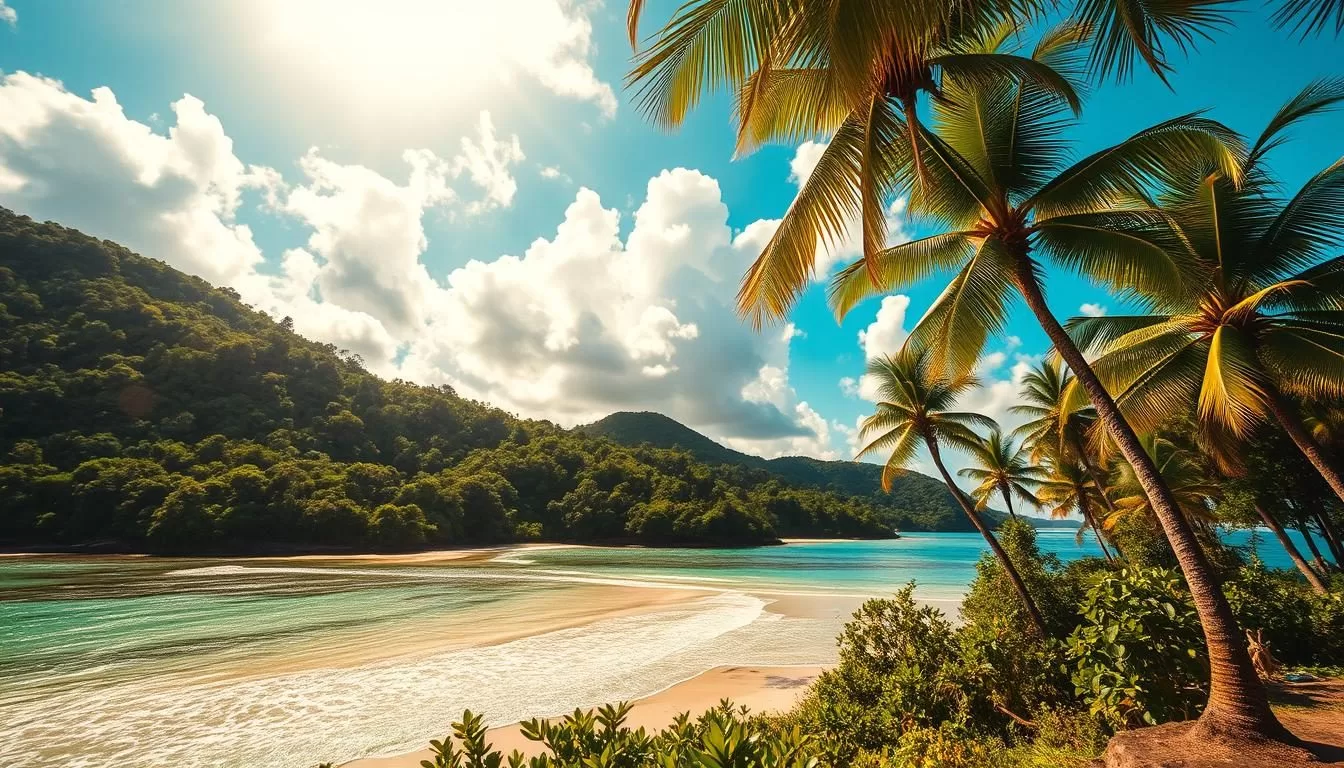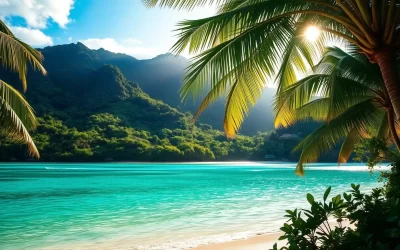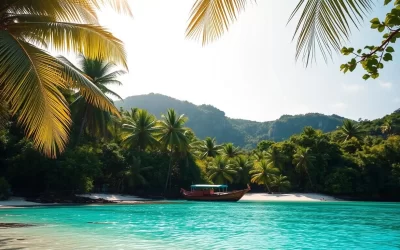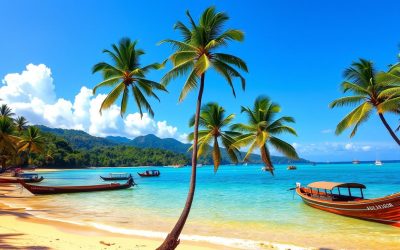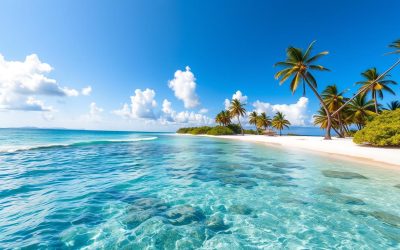Are you ready to experience the pristine beaches and crystal-clear waters of the Andaman and Nicobar Islands? Timing is crucial when planning your trip to this tropical paradise.
The ideal time to visit is between October and May, considered the peak season due to its pleasant weather, making it perfect for water sports and outdoor activities.
Understanding the seasonal variations and how they impact your travel experience is key to a successful trip. You’ll want to know how the dry and monsoon seasons affect the islands’ weather patterns and tourist activities.
Understanding Andaman’s Tropical Climate
Understanding the tropical climate of Andaman is crucial for planning a trip that meets your expectations. The Andaman and Nicobar Islands experience a tropical climate that is characterized by high temperatures and high humidity levels throughout the year.
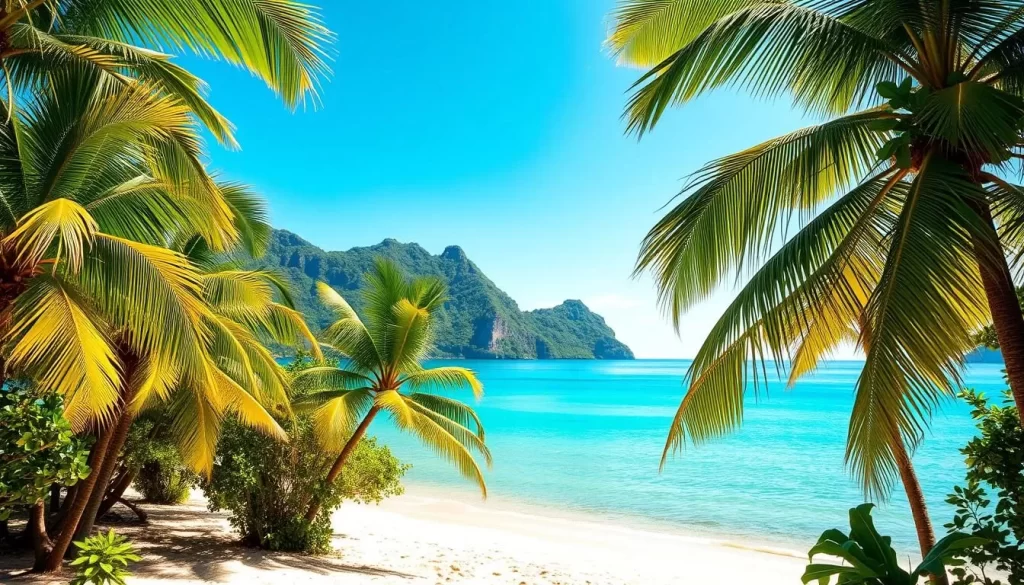
The Year-Round Weather Patterns
The weather in Andaman is influenced by the Northeast and Southwest monsoons, which bring distinct changes in the weather patterns throughout the year. The Northeast monsoon typically brings dry and cool air, while the Southwest monsoon is associated with heavy rainfall and strong winds. The rainfall distribution varies significantly across different months, with the period from June to September receiving the heaviest precipitation, averaging 250-300 mm monthly.
Two Main Seasons: Dry and Monsoon
The year can be broadly divided into two main seasons: the dry season and the monsoon season. The dry season, which lasts from October to May, is characterized by clear skies, calm seas, and optimal conditions for most tourist activities and water sports. In contrast, the monsoon season, from June to September, is marked by heavy rainfall, which can limit certain activities and transportation. However, this season also brings lush greenery to the islands, offering a unique landscape.
During the dry season, the calm seas and clear skies make it an ideal time for water activities such as scuba diving, snorkeling, and beach hopping. The transition periods between the dry and monsoon seasons, namely May-June and September-October, offer unique advantages and challenges for travelers. Understanding these seasonal variations is key to planning a successful trip to Andaman.
Peak Season in Andaman: October to May
The best time to visit Andaman is during its peak season, from October to May. This period offers a unique blend of comfortable weather and exciting activities, making it ideal for travelers from around the world.
Post-Monsoon Bliss: October to December
As the monsoon recedes, October to December brings a post-monsoon bliss to Andaman. The weather is pleasant, with warm temperatures and low humidity, making it perfect for outdoor activities. The islands are lush and green, and the calm seas offer ideal conditions for water sports like snorkeling and diving.
During this time, you can enjoy the serene beaches, explore the local culture, and participate in the festive atmosphere. It’s a great time to visit Andaman before the peak tourist season begins.
Winter Charm: January to March
January marks the beginning of the peak tourist season in Andaman, with tourists flocking to the islands to enjoy the pleasant winter weather. Daytime temperatures are warm, while evenings can be cool, making it essential to pack layers. The calm, clear waters create perfect conditions for water sports and underwater activities like diving and snorkeling.
The Island Tourism Festival in January is a major highlight, showcasing the islands’ cultural diversity through music, dance, food, and crafts. It’s a great time to experience the local culture and enjoy the beaches.
| Month | Weather | Activities |
|---|---|---|
| October to December | Pleasant, warm temperatures | Snorkeling, diving, beach activities |
| January to March | Warm days, cool evenings | Water sports, Island Tourism Festival |
Visiting Andaman during the peak season offers a unique experience, with comfortable weather and a wide range of activities. Whether you’re looking for adventure or relaxation, Andaman has something to offer during this time.
Summer Transition: April and May
The shoulder season, particularly April and May, is an excellent time to experience the best of Andaman’s water sports and activities. As the peak tourist season comes to an end, you can enjoy the islands with fewer crowds, making it an ideal time for adventure enthusiasts.
Pre-Monsoon Weather Conditions
During April and May, Andaman experiences a transition to pre-monsoon weather. The temperatures begin to rise, but the sea remains calm and inviting. This period offers a great opportunity to enjoy water sports like scuba diving, snorkeling, and jet skiing without the peak season rush.
Benefits of Visiting During Shoulder Season
Visiting Andaman during the shoulder season has several advantages. You can expect significantly reduced crowds at popular attractions and beaches, making your trip more enjoyable and relaxed. Accommodation prices also begin to drop in late April and May, offering better value compared to the peak winter months.
- Enjoy water sports and activities with less waiting time.
- Benefit from special promotions offered by tour operators and hotels.
- Plan your daily itinerary around the warmer temperatures.
| Activity | Peak Season | Shoulder Season |
|---|---|---|
| Scuba Diving | Crowded | Less Crowded |
| Snorkeling | Busy | Relaxed |
| Jet Skiing | High Demand | Better Availability |
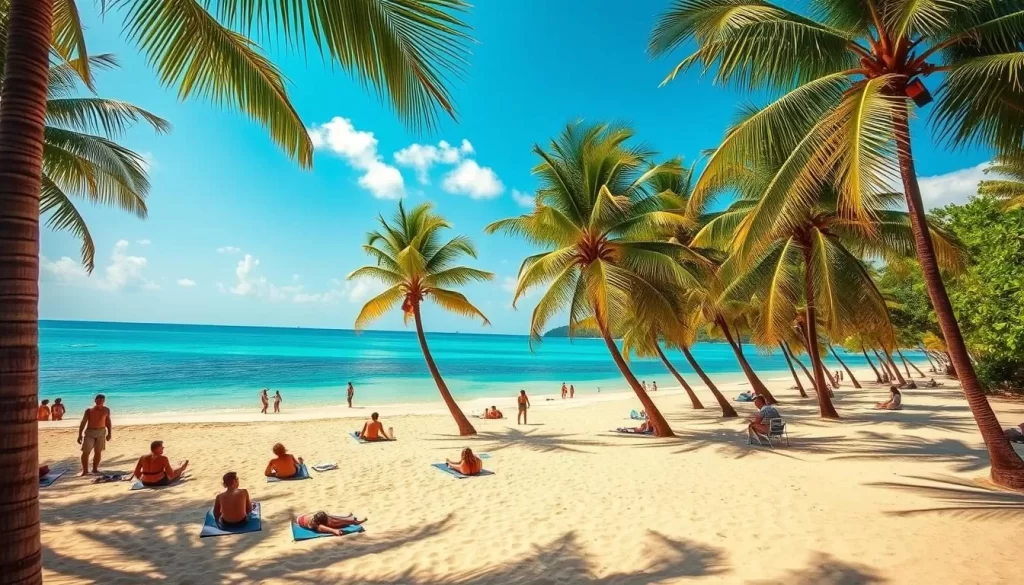
By planning your trip to Andaman during April and May, you can have a fantastic experience with a mix of adventure and relaxation. It’s the best time visit for those looking for a balance between excitement and tranquility.
Monsoon Season: June to September
If you’re looking for a peaceful trip, the monsoon season might be ideal for visiting Andaman. The islands transform into a serene and lush green paradise during this time.
What to Expect During Rainy Months
During the monsoon season, you can expect significant rainfall, which brings a unique charm to the islands. The rain showers make the landscape vibrant and refreshing. While outdoor activities might be limited, the islands offer a range of indoor experiences.
Indoor activities such as visiting museums, historical sites, and cultural attractions become more appealing during this time. You can enjoy a rejuvenating spa treatment or relax at a discounted rate at top resorts and hotels in Port Blair.
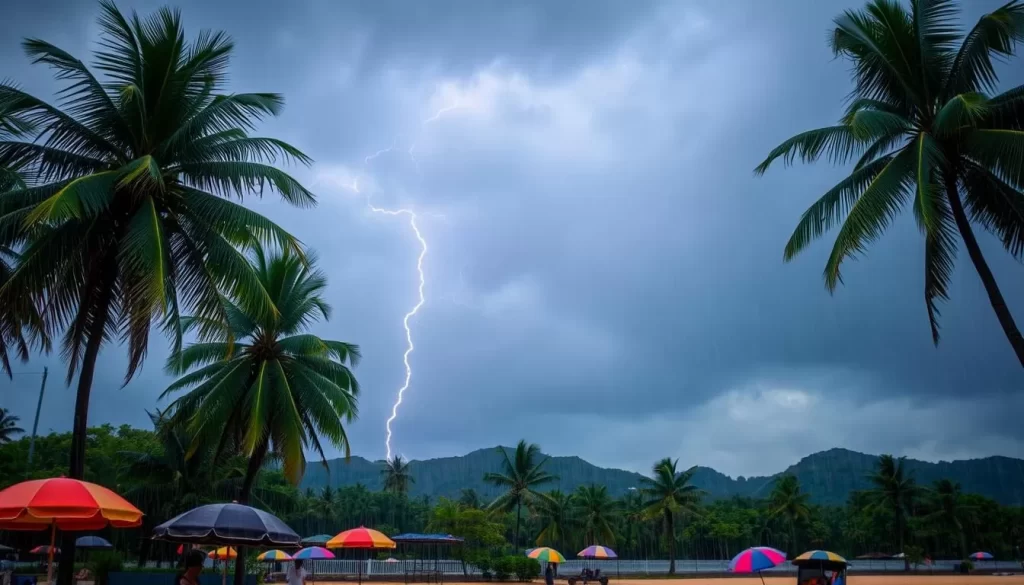
Hidden Advantages of Off-Season Travel
Visiting Andaman during the monsoon season has several hidden advantages. One of the significant benefits is the cost advantage. You can enjoy discounts of up to 50% on accommodations, flights, and some activities. The reduced tourist numbers create a more authentic experience, allowing for deeper connections with local culture and people.
- The lush transformation of the landscape during the monsoon creates a different kind of beauty, with vibrant greenery and refreshed forests.
- Photographers can capture unique atmospheric conditions, including dramatic skies and misty landscapes.
- The rain patterns often allow for outdoor exploration during dry spells, particularly in the morning hours.
Some travelers specifically seek out the monsoon experience for its peaceful ambiance and reflective atmosphere, making it an ideal time for a budget Andaman trip.
Andaman and Nicobar Islands (UT), India: Best Months for a Weather-Savvy Trip
To make the most of your trip to Andaman and Nicobar Islands, understanding the best time to visit is crucial. The islands offer a unique experience throughout the year, but the peak tourist season is particularly popular.
Optimal Weather Windows for First-Time Visitors
For first-time visitors, the period between October and December is ideal due to the pleasant weather following the monsoon season. The sea is calm, making it perfect for water activities like scuba diving and snorkeling. During this time, the islands are less crowded compared to the peak winter months, allowing for a more relaxed experience.
The weather remains favorable until March, with comfortable temperatures and minimal rainfall. This period is excellent for enjoying the beaches, exploring the islands, and participating in various water sports.
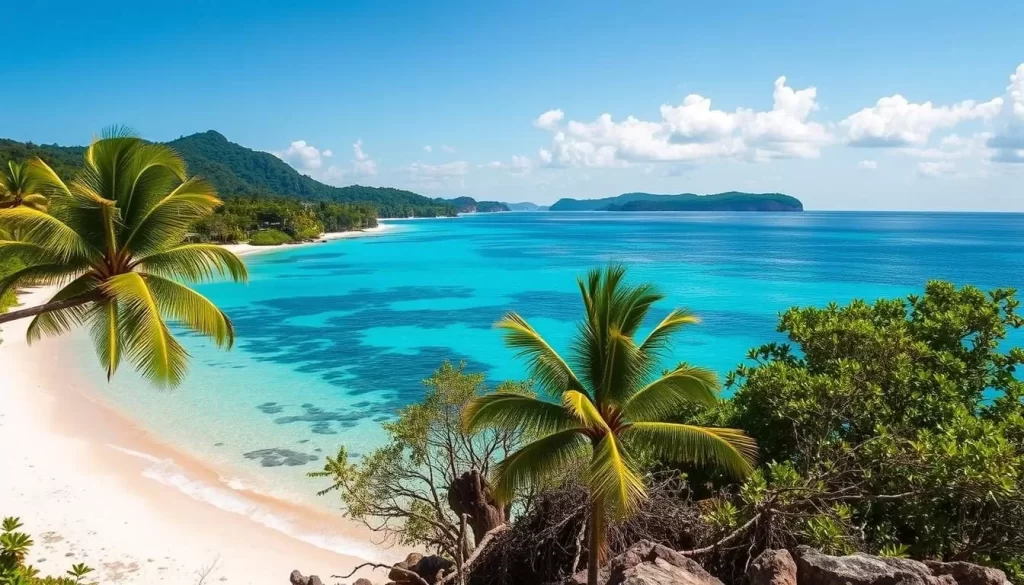
Balancing Weather, Crowds, and Prices
When planning your trip, it’s essential to balance the weather, crowd levels, and prices. The peak season, from January to March, offers the best weather but comes with higher prices and larger crowds. In contrast, the shoulder months (October to December and April to May) provide a good balance between pleasant weather and manageable crowd levels, often at more reasonable prices.
| Season | Weather | Crowd Levels | Prices |
|---|---|---|---|
| Peak (Jan-Mar) | Excellent | High | High |
| Shoulder (Oct-Dec & Apr-May) | Good | Moderate | Moderate |
| Off-Peak (Jun-Sep) | Rainy | Low | Low |
By understanding these factors, you can plan your trip to Andaman and Nicobar Islands according to your preferences, ensuring a memorable experience.
Best Times for Water Activities and Beach Experiences
If you’re planning a trip to the Andaman and Nicobar Islands, timing is everything to make the most of your water activities and beach experiences. The islands offer a paradise for water enthusiasts, with a range of activities to enjoy throughout the year.
Scuba Diving and Snorkeling Seasons
The best time for scuba diving in the Andaman Islands is from December to April, when the sea is calm and visibility is excellent. During these months, you can explore the underwater world, discovering the rich marine life and coral reefs.
The water conditions during this period are ideal, with minimal currents and clear waters, making it perfect for both beginners and experienced divers.

Beach Hopping and Water Sports Calendar
The Andaman and Nicobar Islands offer a range of water sports and activities, including jet skiing, parasailing, and sea walking. The best time for these activities is from December to March, when the weather is pleasant and the sea is calm.
You can enjoy beach hopping and explore the various islands, each with its unique charm and attractions. The water conditions during this period are ideal for swimming, snorkeling, and other water activities.

By planning your trip according to the best time for your preferred activities, you can make the most of your visit to the Andaman and Nicobar Islands. Whether you’re interested in water sports, beach relaxation, or exploring the islands, there’s something for everyone in this tropical paradise.
Month-by-Month Guide to Andaman Weather
Understanding the weather patterns in Andaman and Nicobar Islands is crucial for planning a successful trip. The islands experience a tropical climate, with significant changes throughout the year. A month-by-month guide will help you navigate the best times to visit and make the most of your trip.
October to December: Festival Season and Perfect Weather
From October to December, Andaman experiences a post-monsoon bliss, with pleasant weather and minimal rainfall. The maximum temperature ranges from 28°C to 30°C, while the minimum temperature is around 24°C. This period is ideal for water activities, such as scuba diving and snorkeling, as the waters are calm and clear.
The festival season also kicks in during this time, with various cultural events and celebrations taking place. You can enjoy the islands’ vibrant culture, delicious cuisine, and beautiful beaches, making it a perfect time to visit Andaman.
January to March: Peak Tourist Season
January to March is the peak tourist season in Andaman, with comfortable temperatures and dry weather. The maximum temperature ranges from 29°C to 31°C, while the minimum temperature is around 22°C. The islands are bustling with tourists, and the atmosphere is lively and festive.
This period is ideal for beach activities, such as swimming, sunbathing, and water sports. You can also explore the islands’ natural beauty, including the lush forests, coral reefs, and scenic landscapes.
April to September: From Summer Heat to Monsoon Rains
From April to September, Andaman experiences a significant change in weather, from summer heat to monsoon rains. April is the hottest month, with temperatures reaching up to 33°C, while May marks the beginning of the monsoon season.
The monsoon season, which lasts from June to September, brings heavy rainfall and rough seas, affecting water activities and beach experiences. However, the islands transform into a lush green paradise, with flowing waterfalls and a serene atmosphere.
If you’re planning to visit during this time, be prepared for the challenges and limitations imposed by the monsoon season. However, with the right planning and mindset, you can still have a rewarding and memorable trip.
Planning Your Trip Around Special Events and Festivals
Planning your trip around the special events and festivals in Andaman can enhance your overall travel experience. The islands host a variety of cultural celebrations throughout the year, offering a unique glimpse into the local culture.
Island Tourism Festival (January)
The Island Tourism Festival, held in January, is a significant event that showcases the rich cultural heritage of the Andaman and Nicobar Islands. It’s a great time to visit Andaman and experience the local traditions, music, and dance.

Other Cultural Celebrations Throughout the Year
Apart from the Island Tourism Festival, the Andaman Islands celebrate various other festivals, including Holi in March, Durga Puja and Dussehra in October, and Christmas and New Year Celebrations in December. You can also experience the beauty of the destination during the Monsoon Festival in July and various food and film festivals held throughout the year.
The islands offer a diverse cultural experience, with different communities celebrating their traditional festivals, adding to the charm of the destination. By aligning your visit with these events, you can gain a deeper understanding of the local culture and have a more enriching experience.
Conclusion: Making the Most of Andaman’s Weather
Andaman’s beauty is best appreciated when you visit at the right time, making your trip truly memorable. The islands offer a unique experience throughout the year, with each season having its own charm. While October to March is considered the best time to visit due to its reliable weather, other seasons also have their advantages.
Whether you’re looking for a relaxing beach vacation or an adventure-filled trip, understanding the weather patterns is key. You can enjoy scuba diving, snorkeling, and other water activities during the dry season. Even during the monsoon, there are hidden benefits like fewer crowds and lush landscapes.
To make the most of your Andaman experience, be flexible and plan according to your preferences and budget. With the right mindset and preparation, you can have a wonderful time exploring the islands’ beautiful waters and reefs, regardless of the time you choose to visit this tropical paradise.
The above is subject to change.
Check back often to TRAVEL.COM for the latest travel tips and deals.
